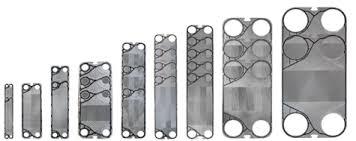Plate heat exchangers play a crucial role in various industries, efficiently transferring heat between two fluids. However, like any mechanical system, plate heat exchangers can encounter issues that affect their performance. In this troubleshooting guide, we will explore common problems that arise with plate heat exchanger spare parts and provide practical solutions to fix them.
I. Insufficient Heat Transfer
One of the most common issues with plate heat exchangers is insufficient heat transfer. This can result from various factors, including fouling, scaling, or improper flow rates. Here are some steps to troubleshoot and resolve this problem:
1. Identifying Fouling or Scaling:
Fouling or scaling occurs when deposits accumulate on the heat transfer surfaces, reducing heat transfer efficiency. To address this issue:
- Inspect the plates for any signs of fouling or scaling.
- Clean the plates using appropriate cleaning agents or methods recommended by the manufacturer.
- Regularly schedule maintenance to prevent fouling or scaling buildup.
2. Checking Flow Rates:
Improper flow rates can also lead to insufficient heat transfer. To resolve this issue:
- Verify that the flow rates of both fluids are within the recommended range.
- Adjust the flow rates if necessary, ensuring they meet the manufacturer's specifications.
- Consider installing flow meters to monitor and maintain optimal flow rates.

II. Leakage Issues
Leakage is another common problem encountered in plate heat exchangers. It can occur due to gasket failure, plate damage, or improper assembly. Follow these steps to troubleshoot and resolve leakage issues:
1. Inspecting Gaskets:
Gaskets provide a seal between the plates, preventing fluid leakage. To address gasket-related issues:
- Examine the gaskets for signs of wear, cracks, or deformation.
- Replace damaged gaskets with compatible spare parts from reputable suppliers.
- Ensure proper gasket installation, following the manufacturer's guidelines.
2. Checking Plate Integrity:
Plate damage can also cause leakage. To resolve this issue:
- Inspect the plates for any signs of damage, such as cracks or corrosion.
- Replace damaged plates with suitable spare parts to maintain the integrity of the heat exchanger.
- Properly align and tighten the plates during assembly to prevent leakage.
III. Uneven Temperature Distribution
Uneven temperature distribution across the plate heat exchanger can lead to reduced efficiency and compromised performance. Here are some steps to troubleshoot and resolve this issue:
1. Balancing Flow Rates:
Balanced flow rates are essential for achieving uniform temperature distribution. To address this issue:
- Ensure that the flow rates of both fluids are balanced.
- Adjust the flow rates by using control valves or flow restrictors.
- Consult the manufacturer's guidelines for recommended flow rate ratios.
2. Inspecting Plate Alignment:
Proper plate alignment is crucial for even heat distribution. To resolve this issue:
- Check the alignment of the plates to ensure they are parallel and properly positioned.
- Realign the plates if necessary, following the manufacturer's instructions.
- Use alignment tools or shims to achieve accurate plate alignment.

IV. Excessive Pressure Drop
Excessive pressure drop can occur in plate heat exchangers, leading to reduced flow rates and increased energy consumption. Follow these steps to troubleshoot and resolve this issue:
1. Cleaning Fouled Plates:
Fouled plates can cause pressure drop. To address this issue:
- Clean fouled plates to remove any debris or deposits that may cause pressure drop.
- Use appropriate cleaning methods or chemicals recommended by the manufacturer.
- Regularly schedule maintenance to prevent excessive fouling.
2. Checking for Blockages:
Blockages in the inlet or outlet ports can also cause pressure drop. To resolve this issue:
- Inspect the inlet and outlet ports for any blockages or obstructions.
- Clear any blockages using suitable tools or cleaning methods.
- Install filters or strainers to prevent future blockages.

Conclusion
https://www.yojointernational.com/Plate-Heat-Exchanger-Spare-Parts/Plate-Heat-Exchanger-Spare-Parts.shtmlare essential to maintaining the optimal performance of these heat transfer systems. By understanding common problems and following the troubleshooting steps outlined in this guide, problems associated with insufficient heat transfer, leaks, uneven temperature distribution, and excessive pressure drop can be effectively identified and resolved. Regular maintenance, proper cleaning, and adherence to manufacturer guidelines will ensure the life and efficiency of your plate heat exchanger.
If you encounter complex or persistent problems, please contact YOJO and our professional technicians will help you.
Choosing the Right Plate Heat Exchanger Spare Parts Solution for Your System

